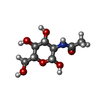+ Open data
Open data
- Basic information
Basic information
| Entry | Database: PDB / ID: 9e6d | ||||||
|---|---|---|---|---|---|---|---|
| Title | octopus sensory receptor CRT1 bound to Lumichrome | ||||||
 Components Components | Chemotactile receptor CRT1 | ||||||
 Keywords Keywords | MEMBRANE PROTEIN / complex | ||||||
| Function / homology |  Function and homology information Function and homology informationextracellular ligand-gated monoatomic ion channel activity / transmembrane signaling receptor activity / membrane Similarity search - Function | ||||||
| Biological species |  Octopus bimaculoides (California two-spot octopus) Octopus bimaculoides (California two-spot octopus) | ||||||
| Method | ELECTRON MICROSCOPY / single particle reconstruction / cryo EM / Resolution: 3.28 Å | ||||||
 Authors Authors | Jiang, H. / Hibbs, R.E. | ||||||
| Funding support |  United States, 1items United States, 1items
| ||||||
 Citation Citation |  Journal: Cell / Year: 2025 Journal: Cell / Year: 2025Title: Environmental microbiomes drive chemotactile sensation in octopus. Authors: Rebecka J Sepela / Hao Jiang / Yern-Hyerk Shin / Tessa L Hautala / Jon Clardy / Ryan E Hibbs / Nicholas W Bellono /  Abstract: Microbial communities coat nearly every surface in the environment and have co-existed with animals throughout evolution. Whether animals exploit omnipresent microbial cues to navigate their ...Microbial communities coat nearly every surface in the environment and have co-existed with animals throughout evolution. Whether animals exploit omnipresent microbial cues to navigate their surroundings is not well understood. Octopuses use "taste-by-touch" chemotactile receptors (CRs) to explore the seafloor, but how they distinguish meaningful surfaces from the rocks and crevices they encounter is unknown. Here, we report that secreted signals from microbiomes of ecologically relevant surfaces activate CRs to guide octopus behavior. Distinct molecules isolated from individual bacterial strains located on prey or eggs bind single CRs in subtly different structural conformations to elicit specific mechanisms of receptor activation, ion permeation and signal transduction, and maternal care and predation behavior. Thus, microbiomes on ecological surfaces act at the level of primary sensory receptors to inform behavior. Our study demonstrates that uncovering interkingdom interactions is essential to understanding how animal sensory systems evolved in a microbe-rich world. | ||||||
| History |
|
- Structure visualization
Structure visualization
| Structure viewer | Molecule:  Molmil Molmil Jmol/JSmol Jmol/JSmol |
|---|
- Downloads & links
Downloads & links
- Download
Download
| PDBx/mmCIF format |  9e6d.cif.gz 9e6d.cif.gz | 585.7 KB | Display |  PDBx/mmCIF format PDBx/mmCIF format |
|---|---|---|---|---|
| PDB format |  pdb9e6d.ent.gz pdb9e6d.ent.gz | 495.6 KB | Display |  PDB format PDB format |
| PDBx/mmJSON format |  9e6d.json.gz 9e6d.json.gz | Tree view |  PDBx/mmJSON format PDBx/mmJSON format | |
| Others |  Other downloads Other downloads |
-Validation report
| Arichive directory |  https://data.pdbj.org/pub/pdb/validation_reports/e6/9e6d https://data.pdbj.org/pub/pdb/validation_reports/e6/9e6d ftp://data.pdbj.org/pub/pdb/validation_reports/e6/9e6d ftp://data.pdbj.org/pub/pdb/validation_reports/e6/9e6d | HTTPS FTP |
|---|
-Related structure data
| Related structure data |  47556MC  9e6bC  9e6cC M: map data used to model this data C: citing same article ( |
|---|---|
| Similar structure data | Similarity search - Function & homology  F&H Search F&H Search |
- Links
Links
- Assembly
Assembly
| Deposited unit | 
|
|---|---|
| 1 |
|
- Components
Components
| #1: Protein | Mass: 47334.262 Da / Num. of mol.: 5 Source method: isolated from a genetically manipulated source Source: (gene. exp.)  Octopus bimaculoides (California two-spot octopus) Octopus bimaculoides (California two-spot octopus)Gene: OCBIM_22006518mg / Production host:  Homo sapiens (human) / References: UniProt: A0A0L8FVQ9 Homo sapiens (human) / References: UniProt: A0A0L8FVQ9#2: Sugar | ChemComp-NAG / #3: Chemical | ChemComp-LUM / Has ligand of interest | Y | Has protein modification | Y | |
|---|
-Experimental details
-Experiment
| Experiment | Method: ELECTRON MICROSCOPY |
|---|---|
| EM experiment | Aggregation state: PARTICLE / 3D reconstruction method: single particle reconstruction |
- Sample preparation
Sample preparation
| Component | Name: octopus sensory receptor CRT1 bound to lumichrome / Type: COMPLEX / Entity ID: #1 / Source: RECOMBINANT |
|---|---|
| Source (natural) | Organism:  Octopus bimaculoides (California two-spot octopus) Octopus bimaculoides (California two-spot octopus) |
| Source (recombinant) | Organism:  Homo sapiens (human) Homo sapiens (human) |
| Buffer solution | pH: 8 |
| Specimen | Embedding applied: NO / Shadowing applied: NO / Staining applied: NO / Vitrification applied: YES |
| Vitrification | Cryogen name: ETHANE |
- Electron microscopy imaging
Electron microscopy imaging
| Experimental equipment |  Model: Titan Krios / Image courtesy: FEI Company |
|---|---|
| Microscopy | Model: TFS KRIOS |
| Electron gun | Electron source:  FIELD EMISSION GUN / Accelerating voltage: 300 kV / Illumination mode: FLOOD BEAM FIELD EMISSION GUN / Accelerating voltage: 300 kV / Illumination mode: FLOOD BEAM |
| Electron lens | Mode: BRIGHT FIELD / Nominal defocus max: 2400 nm / Nominal defocus min: 1400 nm |
| Image recording | Electron dose: 50 e/Å2 / Film or detector model: GATAN K3 BIOCONTINUUM (6k x 4k) |
- Processing
Processing
| EM software | Name: PHENIX / Category: model refinement | ||||||||||||||||||||||||
|---|---|---|---|---|---|---|---|---|---|---|---|---|---|---|---|---|---|---|---|---|---|---|---|---|---|
| CTF correction | Type: PHASE FLIPPING AND AMPLITUDE CORRECTION | ||||||||||||||||||||||||
| 3D reconstruction | Resolution: 3.28 Å / Resolution method: FSC 0.143 CUT-OFF / Num. of particles: 44653 / Symmetry type: POINT | ||||||||||||||||||||||||
| Refine LS restraints |
|
 Movie
Movie Controller
Controller





 PDBj
PDBj





